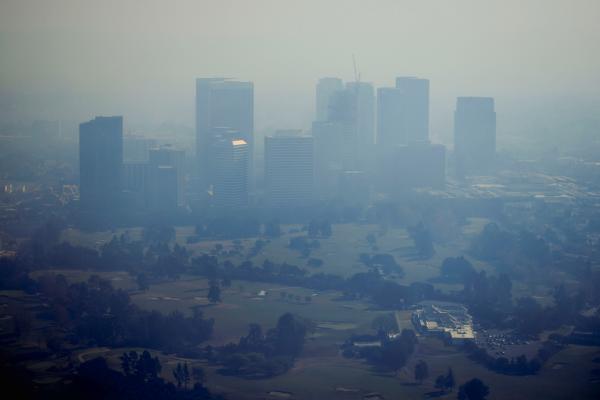LOS ANGELES, Jan 11 — Business was brisk at Teddy's Cocina in Pasadena as wildfire evacuees ate lunch and passersby ducked indoors to escape from the brown, smoky air blanketing the city.
"It is not breathable. We just try to stay indoors," said Dulce Perez, a cook at the restaurant, as an eye-watering haze hung overhead on Thursday about 3.2 km away from one of the multiple fires burning around Los Angeles.
This week, as the wildfires raged and smoke billowed across Los Angeles, officials issued air quality alerts, schools cancelled classes and scientists warned about the dangerous — even fatal — consequences of wildfire smoke.
All around the United States' second-largest city, residents worried about air that has, at times, turned lung-burning from the ash, soot and smoke emanating from fires that have destroyed 10,000 structures.
Air purifiers were sold out at some big-box stores, according to interviews with employees at four businesses. Some residents were taping windows to keep the smoke out of their homes. And Los Angeles officials urged people to stay indoors in areas where smoke was visible.
While conditions improved on Friday, an air quality alert remained in effect until the evening and dangerous particulate matter remained around four times World Health Organisation (WHO) guidelines.
At the Pasadena Convention Center, which has been converted to a temporary shelter, aid workers from actor Sean Penn's global humanitarian organization CORE were handing out N95 masks on Friday.
Emergency response programs manager Sunny Lee said the homeless were particularly vulnerable to bad air.
"There was no place for them to go inside, and so they were suffering even more outside with the poor air quality, without any kind of masks.
"So, we pushed out N95 to our partners that reached those communities. We are distributing as many as we can," she said.
[caption id="attachment_386234" align="aligncenter" width="1310"] An aerial view shows debris from burned properties, following the Palisades Fire at the Pacific Palisades neighbourhood in Los Angeles, California, the United States, on January 10, 2025. — Picture by REUTERS[/caption]
An aerial view shows debris from burned properties, following the Palisades Fire at the Pacific Palisades neighbourhood in Los Angeles, California, the United States, on January 10, 2025. — Picture by REUTERS[/caption]
A hovering haze
Fanned by fierce winds and fueled by vegetation bone-dry after a long period of little or no rain, the Los Angeles fires broke out on Tuesday and have relentlessly burned more than 13,760 hectares, or some 137 square km. Neighbourhoods have turned to ash in some parts of Los Angeles.
Wildfire smoke typically carries with it noxious gases and particulate matter that make it more toxic than normal air pollution. Not only do wildfires burn plants, brush and trees, but also buildings, houses and cars that contain plastics, fuels, metals, and a host of chemicals.
Studies have linked wildfire smoke with higher rates of heart attacks, strokes, cardiac arrests, and weakened immune defences.
Environmental health scientists and doctors warned that particulate matter posed a hazard to people with preexisting lung and heart conditions as well as the elderly and children.
University of California San Diego environmental health scientist Carlos Gould said the concentration of fine particulate matter in the Los Angeles area reached alarming levels between 40 and 100 micrograms per cubic meter earlier in the week before declining to around 20 on Friday.
The WHO recommended maximum is five microgrammes per cubic meter.
"The levels of wildfire smoke we have seen in LA these past few days imply between a five to 15 per cent increase in daily mortality," he said.
Chemical byproducts from the fires, particularly those stemming from burned man-made materials, penetrate deeper into the lungs and can even enter the bloodstream, said American Lung Association spokesman Dr Afif El-Hasan.
"If you are working harder to breathe and your body is being challenged that way, it can also put a strain on the heart. And that's why you see an increase in heart attacks," he said.
Even well outside of the immediate fire zone, residents complained about the smoke. With winds blowing wildfire smoke out to sea, customers at the Potholder Cafe in the coastal community of Long Beach declined to sit outdoors.
Manager Veronica Gutierrez said she bought an air purifier for her home, but it has made little difference.
"We definitely have the smell of burning," she said.
For some people across Los Angeles, the risks will not end when the fires are put out, experts warned.
Los Angeles General Medical Centre burn director Justin Gillenwater expects long-term health impacts from smoke inhalation among people with respiratory conditions and allergies.
"This is going to be something that we are going to be looking into for not just weeks, but really years," he said.
— Reuters
[caption id="attachment_386235" align="aligncenter" width="1088"] An aerial view of Los Angeles amidst the smoke following the Palisades Fire at the Pacific Palisades neighbourhood in Los Angeles, California, the United States, on January 10, 2025. — Picture by REUTERS[/caption]
An aerial view of Los Angeles amidst the smoke following the Palisades Fire at the Pacific Palisades neighbourhood in Los Angeles, California, the United States, on January 10, 2025. — Picture by REUTERS[/caption]




